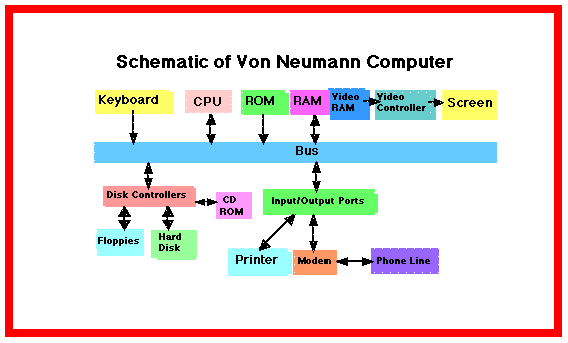
Most computers today are the digital computers based on the von Neumann design principle-(1) a single central processor; (2) a single path between the central processor and memory; (3) program is stored in memory; and (4) central processor fetches, decodes, and executes the stored instructions of the program sequentially. Almost all personal computers, workstations, minicomputers, and mainframes are currently von Neumann design computers. To understand how such a computer works consider the following schematic drawing:

The various components of a computer are:
a. CPU: The central processor unit is the brains of a computer-the circuits to decode and execute instructions. Because of Moore's law, the number of integrated circuits necessary to create a CPU correspondingly decreased until in 1975 the CPU for a personal computer could be designed on a single integrated circuit called a microprocessor. Since that time, each generation of microprocessors is more powerful than the last. Two types of microprocessors are CISC and RISC. Simply put, the instructions for the first type are much more complex than for the latter. Examples of CISC are the Intel 80x86 and Motorola 860x0 series microprocessors. Thus most personal computers are CISC. RISC are more powerful and are found in workstations such as those from SUN. However, Intel is incorporating most of the features of RISC chips in the next generations of its CISC chips. Besides a single CPU a von Neumann design might have several coprocessors-that is subordinates processors for arithmetic and fast video displays.
b. Memory Pyramid As CPU have become faster and more powerful a fundamental bottleneck in computer design is the flow of information back and forth from memory to the CPU. There are now many types of memory devices with different costs, access times and storage capacities. Generally the faster the access time the more expensive the memory. Consequently, good design is based on a memory pyramid of providing increasing amounts of less costly, slower memory.
(1) Cache memory: This generally is memory placed on the CPU or is attached with a special fast bus. It is the fastest and most expensive so little is used.
(2). RAM(DRAM and SRAM) and ROM: These are various types of memory chips directly accessible to the computer. The two most important types of random access memory RAM are dynamic(DRAM) and static(SRAM). The advantage of the latter is that memory is retained when you turn off the computer. Read only memory ROM, is a special type of memory for reading but not writing. This type of memory is useful for storing frequently used software, for which the user needs rapid access but has no need to modify. Memory chips are more expensive and faster than the various types of magnetic and laser disk memories.
As the cost of a bit of integrated circuit storage has been decreasing by about 30-35%each year, it is not surprising that each new generation of computer has much greater RAM storage than the previous generation. For example; the APPLE II had 48K and was expandable to 64K; the MAC started at 128K and now is rarely purchased with less the 4M of RAM. (K stands for one thousand and M stands for one million.)
(3). Magnetic Disk: These are magnetic disks of various types, such as floppies (5 1/4 and 3 1/2) and hard disk. These devices are cheaper and can store much greater amounts of data than RAMs, but have slower access time, which is the amount of time it takes the computer to read information from the magnetic disk into RAM. Generally a computer has a much bigger hard disk memory than the memory on integrated circuits.
(4). Bubble memory: This is an expensive, magnetic type of memory device which currently has not achieved its potential. Bubble memory has the potential to store the information contained in the Library of Congress on a device the size of a 1/4 inch cube. This type of memory has some applications in portable computers.
(5). Laser Disk: A new type of memory device is the laser disk that can store very large amounts of data. This type of memory device is beginning to be used in library application. Cheaper, but much slower than hard disks. CD-ROM refers to read only laser disks.
(6). Holograph memory: This is a new type of memory based on holograph patterns which is just now entering the market. The commercial potential for this type of memory device is very large because it is fast and can store a prodigious amount of information. Thus, this type of memory will be very useful in multimedia computers because the processing power of microprocessors has advanced much faster than the ability to move large amounts of date required for dynamic images from memory to the CPU.
c. Input/Output Devices
Keyboard, mouse and video screen
Printers: Dot matrix impact, Inkjet, Laser,
Modem to phone
Currently a great R&Deffort is being made on pen input devices which can read handwriting. This is a problem in pattern recognition. Also, voice input devices are now becoming a part of PCs. Again, this is a serious problem in pattern recognition.
d. Bus: The bus is the electric circuit connecting the components of the computer together. The more powerful the computer the bigger the bus, where bus size refers to the number of bits which can be communicated at one time. The trend in personal computers has moved from 8 to 16 to 32 and is moving to 64 bits communicated at one time. As we move towards multimedia, the need to move large blocks of data very quickly will increase.
e. Clock: The clock synchronizes the components of a computer to work together. A faster clock enables the computer to execute more instructions a second. Since the 1970s, clocks on personal computers have increased from 1 to over 100 million cycles a second.